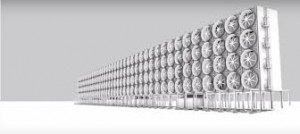In a blog post a couple of weeks ago, I discussed the idea of deliberately manipulating the Earth’s climate in order to mitigate or undue the effects of climate change. This collection of technologies is commonly refereed to as Geo-Engineering and according to Harvard’s Dr. David Keith only a handful of researchers were seriously looking at the technology until 2006 when Nobel Laureate, Paul Crutzen, published a paper in 2006 arguing in favor of doing more research.
Keith’s book, A Case for Climate Engineering, spells out a phased approach which would eventually involve using high altitude jets to release sulfate aerosols into the stratosphere so that they reflect some sunlight and thus cool the earth.
Artificial Volcanos

Sulfate aerosols are favored by Dr. Keith and other researchers in the field because there is already a large amount of data on how such particles behave as a result of studying volcanos such as the 1991 eruption of Mount Pinatubo in the Philippines. The key is to make very small particles so they reflect the most sunlight and get them high enough so they take as much as a year to come down to Earth
One key element of Keith’s plan is to prove out the technology step by step and then slowly ramp up deployment over a number of years. This will allow for unexpected developments and unintended consequences to be well contained and controlled. One of the fears of geo-engineering in general is that the scientists will miscalculate and plunge the earth into a dystopian disaster as depicted in Bong Joon-ho’s film, Snowpiercer. More realistic concerns are that such a program could affect the Monsoons in Asia and/or adversely affect the ozone layer.
The other is to target the program so that it compensates for half of the rate of warming being caused by excess carbon dioxide. Keith argues that the major problem is not the absolute global temperature but its alarming rate of increase and that slowing it down will give humanity time to reduce carbon emissions and also make necessary adaptation to a slightly warmer world. Perhaps the fiercest opposition to geo-engineering research comes form those who worry that the existence of a plan B will make it less likely for the world to act on reducing carbon emissions and thus the whole subject should be taken off the table.
According to his calculations, the cost of such a program would be on the order of $ 1 billion per year at full deployment which is very little compared to the size of the problem and can be done with existing technology. It will require outfitting a fleet of planes to release about 1 million tons of Sulfates into the stratosphere each year (1/8th of Pinatubo). One of the advantages of the approach is that it is reversible and can be halted by simply grounding the planes.
Different problems
Keith makes a strong case to separate the issues of temperature and carbon as they operate differently in the climate system and have very different time scales. The kind of solar radiation management program that he argues for is a short term “band aid” that will decrease the worst impacts of climate change in the immediate future but will do nothing to alter other impacts of a world with high carbon concentration such as changing the alkaline level in the oceans. What he thinks it will do is to make life more tolerable for the bulk of humanity which can not afford other mitigation strategies.

To solve the longer term problem Keith not only argues for decarbonizing our industrial society but has actually started, Carbon Engineering, with some backing from Bill Gates, to develop technology that can remove carbon from the atmosphere.
Perhaps the biggest challenge connected to the deployment of such technology will be how to get the world to agree on what to do and when. The governance of Geo-Engineering will be discussed in the next post in this series.

